formerly eScholarship Editions


|
|
|
|
Your request for similar items found 20 book(s). | Modify Search | Displaying 1 - 20 of 20 book(s) | |
| 1. | 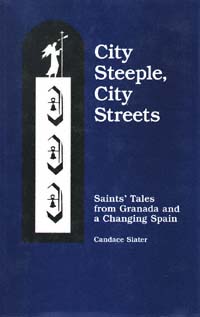 | Title: City steeple, city streets: saints' tales from Granada and a changing Spain Author: Slater, Candace Published: University of California Press, 1990 Subjects: Anthropology | Folklore and Mythology | Literary Theory and Criticism | European Literature Publisher's Description: Candace Slater's new book focuses on narratives concerning Fray Leopoldo de Alpandeire (1864-1956), a Capuchin friar from Granada and probably the most popular nonconsecrated saint today in all of Spain. In tracing the emergence of a group of contemporary legends about Fray Leopoldo, Slater discusses both the stories she tape-recorded in the streets of Granada and the friar's official biography. She underscores the essential pluralism of the tales, their undercurrent of resistance to institutional authority, and their deep concern for the relationship between past and present. Bearing witness to the subtlety and resilience of even the most apparently conservative folk-literary forms, these stories are not only about the role of saints and miracles in an increasingly secular and industrial society but, first and foremost, also about the legacy of the Franco years. [brief] Similar Items |
| 2. | 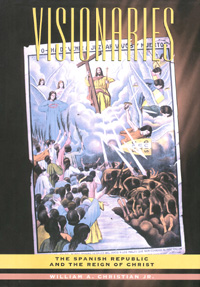 | Title: Visionaries: the Spanish Republic and the reign of Christ Author: Christian, William A 1944- Published: University of California Press, 1996 Subjects: Religion | Christianity | Popular Culture | Anthropology Publisher's Description: In June 1931, on a hillside in the Spanish Basque country, two children reported seeing the Virgin Mary. Within weeks, hundreds of seers were attracting tens of thousands of onlookers, and the nightly spectacle gave rise to others in dozens of towns across Spain. Visionaries explores the experience and the larger meaning of this wave.Immersing himself in the lives of the visionaries, William Christian retraced their steps and recreated their world. He spoke with hundreds of witnesses, who led him to caches of vision messages, diaries, clandestine publications, and eloquent photographs. He describes two kinds of visionaries and their relation to each other: the seers who had visions of Mary and the saints, and the believers who had a vision for the future, which they hoped Mary and the saints would confirm. Together, these visionaries attempted to convince a skeptical world that heavenly beings were appearing on the Iberian peninsula. By turns intense, poignant, fierce, and funny, this long-hidden history demonstrates the vital role of the extraordinary in giving voice to a society's hope and anguish. [brief] Similar Items |
| 3. | 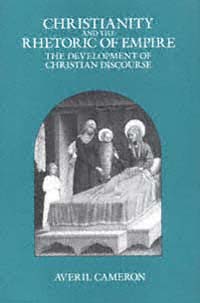 | Title: Christianity and the rhetoric of empire: the development of Christian discourse Author: Cameron, Averil Published: University of California Press, 1991 Subjects: Classics | Classical Religions | Classical History | History | Christianity | Ancient History | Rhetoric Publisher's Description: Many reasons can be given for the rise of Christianity in late antiquity and its flourishing in the medieval world. In asking how Christianity succeeded in becoming the dominant ideology in the unpromising circumstances of the Roman Empire, Averil Cameron turns to the development of Christian discourse over the first to sixth centuries A.D., investigating the discourse's essential characteristics, its effects on existing forms of communication, and its eventual preeminence. Scholars of late antiquity and general readers interested in this crucial historical period will be intrigued by her exploration of these influential changes in modes of communication.The emphasis that Christians placed on language - writing, talking, and preaching - made possible the formation of a powerful and indeed a totalizing discourse, argues the author. Christian discourse was sufficiently flexible to be used as a public and political instrument, yet at the same time to be used to express private feelings and emotion. Embracing the two opposing poles of logic and mystery, it contributed powerfully to the gradual acceptance of Christianity and the faith's transformation from the enthusiasm of a small sect to an institutionalized world religion. [brief] Similar Items |
| 4. | 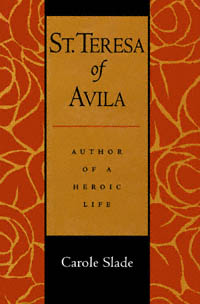 | Title: St. Teresa of Avila: author of a heroic life Author: Slade, Carole Published: University of California Press, 1995 Subjects: Religion | Christianity | Women's Studies | Autobiographies and Biographies | Renaissance History Publisher's Description: With few exceptions, representations of Renaissance women were created by men. The Spanish saint, Teresa of Avila (1515-1582), who chose to represent herself, was one of those exceptions. What prompted her to write Book of Her Life, Interior Castle , and other works? What does the self-portrait of this sixteenth-century nun, mystic, and founder of convents reveal about its author, the church, state, and role of women? St. Teresa of Avila , an innovative analysis of Teresa's autobiographical writings, explores these and many other questions. Bringing to bear a knowledge of Inquisition studies, theory of autobiography, scriptural hermeneutics, and hagiography, Carole Slade defines Teresa's writings as a project of self-interpretation undertaken mainly as the result of the perceived, later realized, threat of an accusation of heresy. Being female and of paternal Jewish ancestry, Teresa was vulnerable to such a charge.Teresa's writing project presented her with serious difficulties. Judicial confession, her prescribed genre, presumed the writer's guilt, while the subordinate female script precluded a defense against the suspicion that her mystical experiences came from the devil. Through careful textual analysis, Slade demonstrates that Teresa exploited the nuances of numerous genres - hagiography, New World chronicle, mystical theological treatise, and early novel - to create an innocent textual persona and depict herself in heroic terms.A signal contribution to our understanding of Teresa's rhetorical and literary talent and life circumstances, this book will engage readers across a broad range of disciplines. [brief] Similar Items |
| 5. | 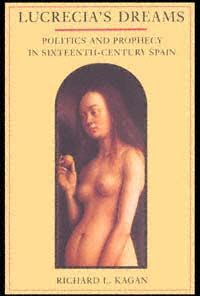 | Title: Lucrecia's dreams: politics and prophecy in sixteenth-century Spain Author: Kagan, Richard L 1943- Published: University of California Press, 1990 Subjects: History | Renaissance History | Women's Studies | Gender Studies Publisher's Description: Branded by the Spanish Inquisition as an "evil dreamer," a "notorious mother of prophets," the teenager Lucrecia de León had hundreds of bleak but richly imaginative dreams of Spain's future that became the stuff of political controversy and scandal. Based upon surviving transcripts of her dreams and on the voluminous records of her trial before the Inquisition, Lucrecia's Dreams traces the complex personal and political ramifications of Lucrecia's prophetic career. This hitherto unexamined episode in Spanish history sheds new light on the history of women as well as on the history of dream interpretation.Charlatan or clairvoyant, sinner or saint, Lucrecia was transformed by her dreams into a cause celébre , the rebellious counterpart to that other extraordinary woman of Golden Age Spain, St. Theresa of Jesus. Her supporters viewed her as a divinely inspired seer who exposed the personal and political shortcomings of Philip II of Spain. In examining the relation of dreams and prophecy to politics, Richard Kagan pays particular attention to the activities of the streetcorner prophets and female seers who formed the political underworld of sixteenth-century Spain. [brief] Similar Items |
| 6. | 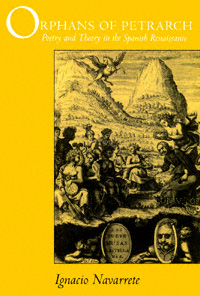 | Title: Orphans of Petrarch: poetry and theory in the Spanish Renaissance Author: Navarrete, Ignacio Enrique 1954- Published: University of California Press, 1994 Subjects: Literature | Literary Theory and Criticism | Poetry | Renaissance Literature Publisher's Description: In Spain as elsewhere, Renaissance poets transformed the lyric tradition by using Petrarch as a source of poetic renewal. But political unity and military hegemony, coupled with a sense of cultural inferiority and an obsession with ethnic purity, made Spain different. Drawing on modern critical theory, Ignacio Navarrete offers a new exposition of the development of Spanish Renaissance poetics. Grounded in both philology and cultural theory, Orphans of Petrarch is the first book to integrate the "Spanish difference" into an understanding of Renaissance lyric as a European phenomenon. [brief] Similar Items |
| 7. | 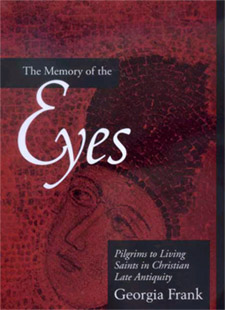 | Title: The memory of the eyes: pilgrims to living saints in Christian late antiquity Author: Frank, Georgia 1963- Published: University of California Press, 2000 Subjects: Religion | Christianity | Classical Religions | Classical History Publisher's Description: Pilgrims in the deserts of Egypt and the holy land during the fourth and fifth centuries A.D. often reported visiting holy people as part of their tours of holy places. This is the first comprehensive study of pilgrimage to these famous ascetics of late antique Christianity. Through an original analysis of pilgrim writings of this period, Georgia Frank discovers a literary imagination at work, one that both recorded and shaped the experience of pilgrimage to living saints. Taking an important new approach to these texts, Frank finds in them a record of the writers' and readers' spiritual expectations and uses these fresh insights to add substantially to our understanding of the purposes and practices of pilgrimage. Frank focuses in particular on two important and well-known early texts - The History of the Monks in Egypt (ca. 400) and Palladius's The Lausiac History (ca. 420), situating these narratives in their literary, historical, and spiritual contexts. She compares these narratives to exotic travel writing and to tales of otherworldly journeys. Bringing in contemporary theory, she demonstrates the importance of sight as a means of spiritual progress and explores the relation between the function of sight in these narratives and in other expressions of visual piety in late antiquity Christianity, such as the veneration of relics and, eventually, icons. With its unique focus on the sensory dimensions of pilgrimage - especially visuality - this absorbing book widens our understanding of early Christian pilgrims and those who read their accounts. At the same time, it also sheds new light on the relation between religious experience and the senses, on literary representations of visual experience, and on the literature of pious travel. [brief] Similar Items |
| 8. | 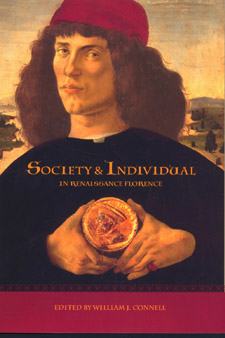 | Title: Society and individual in Renaissance Florence Author: Connell, William J Published: University of California Press, 2002 Subjects: History | Renaissance History | European History Publisher's Description: Renaissance Florence has often been described as the birthplace of modern individualism, as reflected in the individual genius of its great artists, scholars, and statesmen. The historical research of recent decades has instead shown that Florentines during the Renaissance remained enmeshed in relationships of family, neighborhood, guild, patronage, and religion that, from a twenty-first-century perspective, greatly limited the scope of individual thought and action. The sixteen essays in this volume expand the groundbreaking work of Gene Brucker, the historian in recent decades who has been most responsible for the discovery and exploration of these pre-modern qualities of the Florentine Renaissance. Exploring new approaches to the social world of Florentines during this fascinating era, the essays are arranged in three groups. The first deals with the exceptionally resilient and homogenous Florentine merchant elite, the true protagonist of much of Florentine history. The second considers Florentine religion and Florence's turbulent relations with the Church. The last group of essays looks at criminals, expatriates, and other outsiders to Florentine society. [brief] Similar Items |
| 9. | 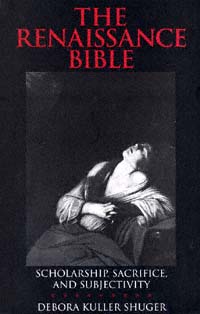 | Title: The Renaissance Bible: scholarship, sacrifice, and subjectivity Author: Shuger, Debora K 1953- Published: University of California Press, 1994 Subjects: Literature | Religion | Literary Theory and Criticism | Renaissance History | Christianity | Renaissance Literature Publisher's Description: This is the first book on the Renaissance Bible by an Anglo-American scholar in nearly fifty years. Not confined to a history of exegesis, it is instead a study of Renaissance culture - a culture whose central text was the Bible. Shuger explores, among other topics, the links between late medieval Christology and early modern subjectivity; religious eroticism and the origins of the sexualized body; the transformation of humanist philology into comparative religion; and the representation of daughter-sacrifice and female erotic desire. [brief] Similar Items |
| 10. | 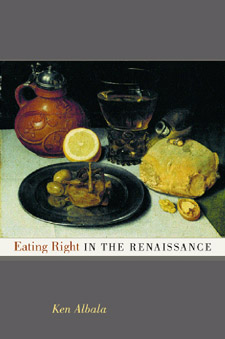 | Title: Eating right in the Renaissance Author: Albala, Ken 1964- Published: University of California Press, 2002 Subjects: Food and Cooking | Renaissance History | History of Science | History of Food Publisher's Description: Eating right has been an obsession for longer than we think. Renaissance Europe had its own flourishing tradition of dietary advice. Then, as now, an industry of experts churned out diet books for an eager and concerned public. Providing a cornucopia of information on food and an intriguing account of the differences between the nutritional logic of the past and our own time, this inviting book examines the wide-ranging dietary literature of the Renaissance. Ken Albala ultimately reveals the working of the Renaissance mind from a unique perspective: we come to understand a people through their ideas on food. Eating Right in the Renaissance takes us through an array of historical sources in a narrative that is witty and spiced with fascinating details. Why did early Renaissance writers recommend the herbs parsley, arugula, anise, and mint to fortify sexual prowess? Why was there such a strong outcry against melons and cucumbers, even though people continued to eat them in large quantities? Why was wine considered a necessary nutrient? As he explores these and other questions, Albala explains the history behind Renaissance dietary theories; the connections among food, exercise, and sex; the changing relationship between medicine and cuisine; and much more. Whereas modern nutritionists may promise a slimmer waistline, more stamina, or freedom from disease, Renaissance food writers had entirely different ideas about the value of eating right. As he uncovers these ideas from the past, Ken Albala puts our own dietary obsessions in an entirely new light in this elegantly written and often surprising new chapter on the history of food. [brief] Similar Items |
| 11. | 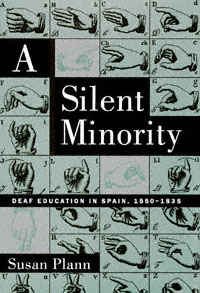 | Title: A silent minority: deaf education in Spain, 1550-1835 Author: Plann, Susan Published: University of California Press, 1997 Subjects: History | Language and Linguistics | Medieval History | European History | Education | European Studies | Medieval Studies | Cultural Anthropology | Cultural Anthropology Publisher's Description: This timely, important, and frequently dramatic story takes place in Spain, for the simple reason that Spain is where language was first systematically taught to the deaf. Instruction is thought to have begun in the mid-sixteenth century in Spanish monastic communities, where the monks under vows of silence employed a well-established system of signed communications. Early in the 1600s, deaf education entered the domain of private tutors, laymen with no use for manual signs who advocated oral instruction for their pupils. Deaf children were taught to speak and lip-read, and this form of deaf education, which has been the subject of controversy ever since, spread from Spain throughout the world.Plann shows how changing conceptions of deafness and language constantly influenced deaf instruction. Nineteenth-century advances brought new opportunities for deaf students, but at the end of what she calls the preprofessional era of deaf education, deaf people were disempowered because they were barred from the teaching profession. The Spanish deaf community to this day shows the effects of the exclusion of deaf teachers for the deaf.The questions raised by Plann's narrative extend well beyond the history of deaf education in Spain: they apply to other minority communities and deaf cultures around the world. At issue are the place of minority communities within the larger society and, ultimately, our tolerance for human diversity and cultural pluralism. [brief] Similar Items |
| 12. | 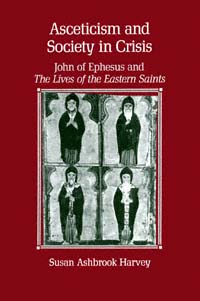 | Title: Asceticism and society in crisis: John of Ephesus and the Lives of the Eastern saints Author: Harvey, Susan Ashbrook Published: University of California Press, 1990 Subjects: Classics | Classical Religions | Classical History Publisher's Description: John of Ephesus traveled throughout the sixth-century Byzantine world in his role as monk, missionary, writer and church leader. In his major work, The Lives of the Eastern Saints , he recorded 58 portraits of monks and nuns he had known, using the literary conventions of hagiography in a strikingly personal way. War, bubonic plague, famine, collective hysteria, and religious persecution were a part of daily life and the background against which asceticism developed an acute meaning for a beleaguered populace. Taking the work of John of Ephesus as her guide, Harvey explores the relationship between asceticism and society in the sixth-century Byzantine East.Concerned above all with the responsibility of the ascetic to lay society, John's writing narrates his experiences in the villages of the Syrian Orient, the deserts of Egypt, and the imperial city of Constantinople. Harvey's work contributes to a new understanding of the social world of the late antique Byzantine East, skillfully examining the character of ascetic practices, the traumatic separation of "Monophysite" churches, the fluctuating roles of women in Syriac Christianity, and the general contribution of hagiography to the study of history. [brief] Similar Items |
| 13. | 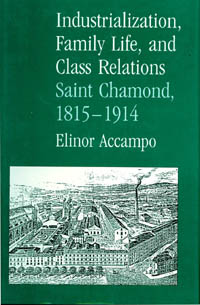 | Title: Industrialization, family life, and class relations: Saint Chamond, 1815-1914 Author: Accampo, Elinor Ann Published: University of California Press, 1989 Subjects: History | European History | Women's Studies Publisher's Description: In this provocative study, Elinor Accampo explores the interrelationship between the structure of work and strategies of family formation in Saint Chamond, a French city that underwent intensive industrialization during the nineteenth century. Through a detailed analysis of fertility, mortality, marriages, and migration, the author analyzes the ways in which the family responded to changes in the organization of work. In the first half of the nineteenth century work was in the home, and families tended to be large in order to meet the demand for workers. But by the 1860s the mechanization of labor had begun to separate family life and work life, fundamentally transforming the relationship between work and family and making the survival of the working-class family more difficult. Accampo argues that workers began to have smaller families much earlier than has previously been suggested, and she demonstrates that fertility declined for reasons unique to working-class conditions. This decline in family size, and the context in which it took place, provides fascinating new material for understanding the working class world and the dynamics of class relations. [brief] Similar Items |
| 14. | 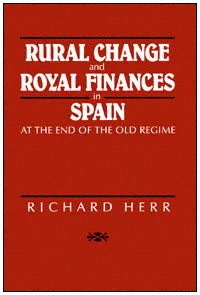 | Title: Rural change and royal finances in Spain at the end of the old regime Author: Herr, Richard Published: University of California Press, 1989 Subjects: History | European History Similar Items |
| 15. | 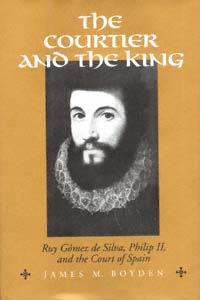 | Title: The courtier and the King: Ruy Gómez de Silva, Philip II, and the court of Spain Author: Boyden, James M 1954- Published: University of California Press, 1995 Subjects: History | European History | Autobiographies and Biographies Publisher's Description: Ruy Gómez de Silva, or the prince of Eboli, was one of the central figures at the court of Spain in the sixteenth century. Thanks to his oily affability, social grace, and an uncanny knack for anticipating and catering to the desires of his prince, he rose from obscurity to become the favorite and chief minister of Philip II.From the scattered surviving sources James Boyden weaves a vivid, compelling narrative: one that breathes life not only into Ruy Gómez, but into the court, the era, and the enigmatic character of Phillip II as well. Elegantly written and highly readable, this book discovers in the career of Gómez the techniques, aspirations, and mentality of an accomplished courtier in the age of Castiglione. [brief] Similar Items |
| 16. | 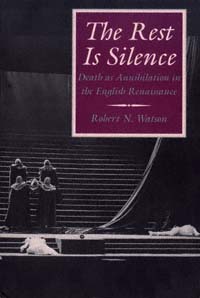 | Title: The rest is silence: death as annihilation in the English Renaissance Author: Watson, Robert N Published: University of California Press, 1995 Subjects: Literature | English Literature | Literary Theory and Criticism | Renaissance Literature Publisher's Description: How did the fear of death coexist with the promise of Christian afterlife in the culture and literature of the English Renaissance? Robert Watson exposes a sharp edge of blasphemous protest against mortality that runs through revenge plays such as The Spanish Tragedy and Hamlet , and through plays of procreation such as Measure for Measure and Macbeth . Tactics of denial appear in the vengefulness that John Donne directs toward female bodies for failing to bestow immortality, and in the promise of renewal that George Herbert sets against the threat of closure.Placing these literary manifestations in the context of specific Jacobean deathbed crises and modern cultural distortions, Watson explores the psychological roots and political consequences of denying that death permanently erases sensation and consciousness. [brief] Similar Items |
| 17. | 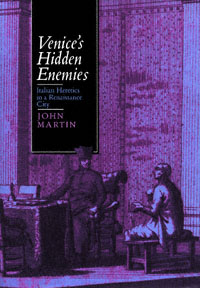 | Title: Venice's hidden enemies: Italian heretics in a Renaissance city Author: Martin, John Jeffries Published: University of California Press, 1993 Subjects: History | European History | Christianity | Renaissance History Publisher's Description: How could early modern Venice, a city renowned for its political freedom and social harmony, also have become a center of religious dissent and inquisitorial repression? To answer this question, John Martin develops an innovative approach that deftly connects social and cultural history. The result is a profoundly important contribution to Renaissance and Reformation studies.Martin offers a vivid re-creation of the social and cultural worlds of the Venetian heretics - those men and women who articulated their hopes for religious and political reform and whose ideologies ranged from evangelical to anabaptist and even millenarian positions. In exploring the connections between religious beliefs and social experience, he weaves a rich tapestry of Renaissance urban life that is sure to intrigue all those involved in anthropological, religious, and historical studies - students and scholars alike. [brief] Similar Items |
| 18. | 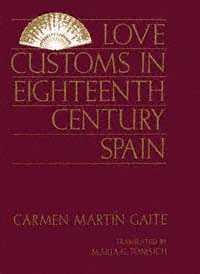 | Title: Love customs in eighteenth-century Spain Author: Martín Gaite, Carmen Published: University of California Press, 1991 Subjects: History | European History | Gender Studies Similar Items |
| 19. | 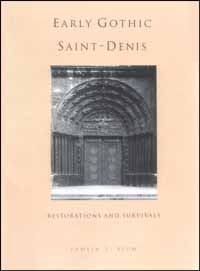 | Title: Early Gothic Saint-Denis: restorations and survivals Author: Blum, Pamela Z Published: University of California Press, 1992 Subjects: Art | Architectural History | Art History | Medieval Studies | Archaeology Publisher's Description: quality. Indeed, the well-preserved sculptural passages provide a key to the Early Gothic style as well as revealing the distinct imprints of three artists and their influences on each other. Blum's penetrating analyses of the restorative techniques and materials are accompanied by telling photograph-diagrams that distinguish the original work from that done later.Pamela Blum's investigation has relevance not only for students and scholars of medieval art but for curators and collectors as well. Anyone concerned with survivals from the past will appreciate her scrupulous detection in studying one of France's greatest monuments. [brief] Similar Items |
| 20. |  | Title: Jewish life in renaissance Italy Author: Bonfil, Roberto Published: University of California Press, 1994 Subjects: Jewish Studies | Renaissance History | European History Publisher's Description: With this heady exploration of time and space, rumors and silence, colors, tastes, and ideas, Robert Bonfil recreates the richness of Jewish life in Renaissance Italy. He also forces us to rethink conventional interpretations of the period, which feature terms like "assimilation" and "acculturation." Questioning the Italians' presumed capacity for tolerance and civility, he points out that Jews were frequently uprooted and persecuted, and where stable communities did grow up, it was because the hostility of the Christian population had somehow been overcome.After the ghetto was imposed in Venice, Rome, and other Italian cities, Jewish settlement became more concentrated. Bonfil claims that the ghetto experience did more to intensify Jewish self-perception in early modern Europe than the supposed acculturation of the Renaissance. He shows how, paradoxically, ghetto living opened and transformed Jewish culture, hastening secularization and modernization.Bonfil's detailed picture reveals in the Italian Jews a sensitivity and self-awareness that took into account every aspect of the larger society. His inside view of a culture flourishing under stress enables us to understand how identity is perceived through constant interplay - on whatever terms - with the Other. [brief] Similar Items |